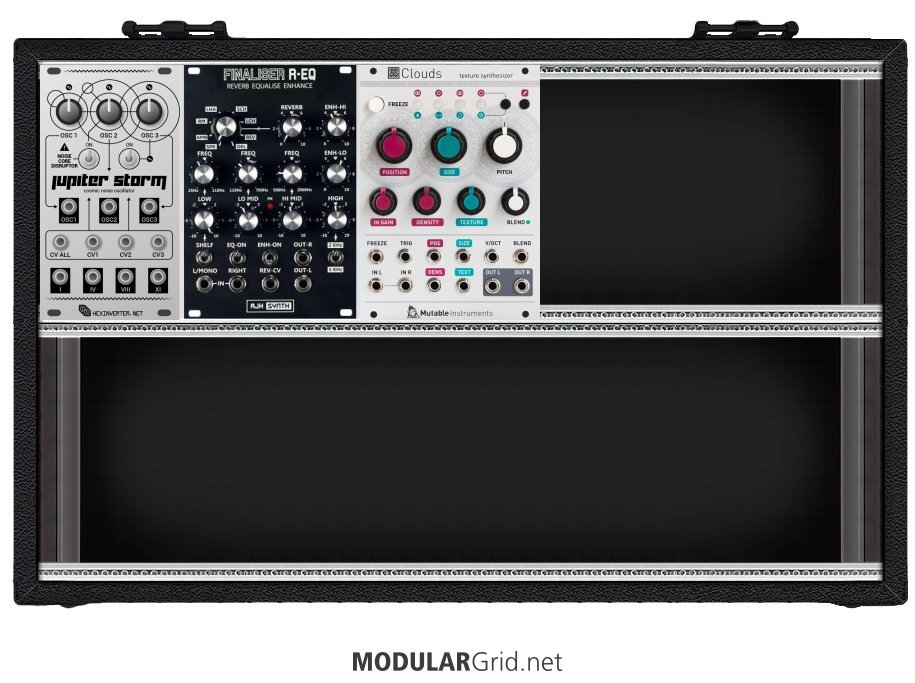Total agreement, Ronin...danjas, I'd strongly suggest you consider a patchable synth first. Embarking on a course that leads into modular synths is the sort of thing that will turn into a pointless money pit very rapidly until/unless you understand the basics of synthesizers first.
First of all, THIS IS EXPENSIVE. Period. If you're going to mimic artists who have budgets to work with when you yourself don't, you're going to find all of this intensely frustrating. You're talking about an instrument which not only requires you to have the technical knowledge to configure it, but whose case alone will run you a minimum of $350-ish. And then, within that case, each row will run you between $1500-2500 (assuming 104 hp, which is the "best case" ultra-basic scenario with a Tiptop Mantis). You'll then need a pile of patchcords...so, another $150 or such, unless you're adept with wire strippers and a soldering iron. If you doubt these figures, then have a look at some preconfigured modular system (in the same general form factor as your cab above) prices: Make Noise Shared System = $4495, Pittsburgh Lifeforms Evo = $3799, Erica Techno System = $4399, Doepfer Basic System 2 = $2599, Doepfer Basic System 1 = $2549. And these are all rather basic systems, nothing really esoteric there.
Secondly, do you know your synth programming well enough to anticipate what will be necessary in addition to the "sexy" modules? In short, what will those modules need to make them work in a suitable manner...because they sure as hell won't turn sonic backflips without the other not so seemingly "important and irreplaceable modules". Ronin is spot-on when he says "...you're going to have to be comfortable in a modular environment first before you can make it applicable towards any kind of meaningful production", which brings us back to patchables. Many of us on here got our initial experiences on these, because a well-implemented patchable synth will give you the feel of a modular environment without the cost and with all of the necessary circuits to make it work as a modular synth should. Get some experience in with the basics...and then, later on, incorporate that patchable into a fully-modular setup (because that should be easy).
Third, do you know your modular environment dos, don't and whys? For example, what can happen if you patch two outputs into the same multiple? Why would that happen? How would you avoid that? This is ONE example of a myriad of examples that modular users just know, and it's also part of being "comfortable in a modular environment". Or, why do you need so many VCAs? What do you do with them? Why would you leave dedicated multiple modules out of a small build? Why would you loop an envelope? How can that be made to work like an oscillator? What's with all of these different waveforms? THESE are basics in modular (and pretty much every other) synthesis - along with lots more - that are pretty useful to have a grasp of prior to throwing out a stack o' cash. And this, again, goes back to exploring in a more sensible and less spendy manner with a patchable.
Last, why do you "need" a modular? Have you been doing music for a long enough period of time that you understand the sonic elements that are lacking in your current work, and which can only be dealt with via a modular synth? It's worth noting that techno...at its most basic...is a music that developed around what was cheap and available to musicians in American inner city environments. And as a result, this is why we have some instruments that used to be utter commercial disasters which now cost an arm and a leg (Roland TB-303, I'm lookin' right atcha!) but it's also how we know that other synths that were (and, stupidly, still sometimes are) dismissed as "toys" turned out to have massive potential, such as the Yamaha 4-op FM synths like the DX-9, 21, 27, and 100 or Casio's PDM synths in the CZ line. I have actually caused structural damage to a performance space thanks to a subbass patch I perfected on the CZ-101 (which is sitting 4 feet to my left as I type this) plus 25 kW of subs...and that synth cost me $40 at a pawn shop. Pretty effing cost-effective, if you ask me!
My advice: calm down. You probably don't totally require a modular synth, and while getting one seems like it might be a gateway to being a TEKKNO SUPAHSTAHH...the reality is that it's more likely to be a gateway to massive monetary outlay and considerable frustration. Especially with this idea that you can check out other peoples' gear and replicate it, ergo you will arrive at massive success. Nuh-uh. If that were the case, everyone who ever bought a 12-string Rickenbacker would instantly become yet another George Harrison clone...and we don't see that happening, not back in the 1960s, not now, and not ever. The real solutions here involve developing YOUR sound, YOUR abilities, YOUR knowledge base, and so on; talent, knowledge and creativity don't come in an economy-sized box on a music store shelf. Work on those first...then worry about where to go with those honed skills later!


